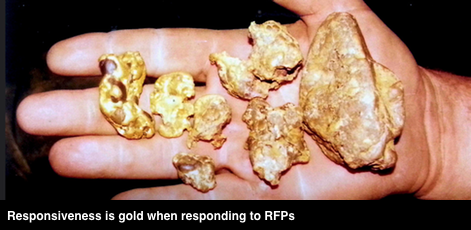An earlier post made the case that merely meeting compliance requirements is not enough to win large RFPs. Buyers rightly expect bidders to show how their solutions will do more than meet the bare minimum.
A responsive proposal shows deep understanding of the prospect and the project—beyond what’s in the RFP—and provides reasons to believe your team “gets it” and will deliver success.
Strategic drivers and hot button issues
- Strategic drivers: Every RFP is issued in response to one or more needs. Those needs may have existed for some time. Strategic drivers explain why the prospect has decided to make this investment now. Is it defending against a competitor’s move? Is it fighting a decline in market share? Does it see a new business opportunity? Is it seeking to reduce costs? Is it facing compliance issues?
- Hot button issues: In addition to strategic drivers, every prospect will have issues it wants addressed. Among these are hot button issues, items that are top-of-mind for the prospect—or for some evaluator(s)—perhaps because of a prior bad experience. These could include:
- Desire for cost certainty
- Need for on-time completion
- Technology preferences
- Safety concerns
- Transition costs and hassle
- Ease of use
- Smooth business relations
Understanding strategic drivers and hot button issues gives you a significant leg up in developing and describing your solution. You’ll know, for example, which features and benefits to stress, how best to make performance-vs-cost and other trade-offs and—crucially—how to describe your solution in ways that resonate with evaluators.
Project factors
In addition to addressing strategic needs and hot button issues, you’ll want to show you understand and can satisfy the project requirements and the challenges and risks they present. These will be unique to the project and can range from building site characteristics, to environmental requirements, to traffic management, to winter weather, to the need to time installations to accommodate seasonal demands on the end users’ time.
Show responsiveness to project factors by citing past experience and success in managing similar projects. Provide examples where your team has innovated solutions to challenges identical or very similar to those this project is likely to present. If possible, cite examples using the same key individuals as those you’ve nominated in your proposal.
Drivers and issues change over time
Don’t assume what mattered to a prospect in a previous RFP still matters today. As technologies mature, for example, reliability typically becomes a given and relative cost becomes more important. As processes and markets evolve, energy efficiency, for example, may outrank throughput in priority.
Ensure your assumptions about drivers and issues are as current as possible (see below).
Leverage sales knowledge
This post explains how building your proposal around deep (and current) knowledge of the project and prospect is the key to developing a top-scoring offer. The importance of gaining this intel highlights the critical role of business developers in crafting responsive proposals.
Most successful bidders for complex contracts have business developers trained to build close relationships with multiple prospect team members, to listen carefully, and to keep notes. Then, when the RFP is finally issued, they can mine their accumulated knowledge for nuggets of responsiveness gold.


